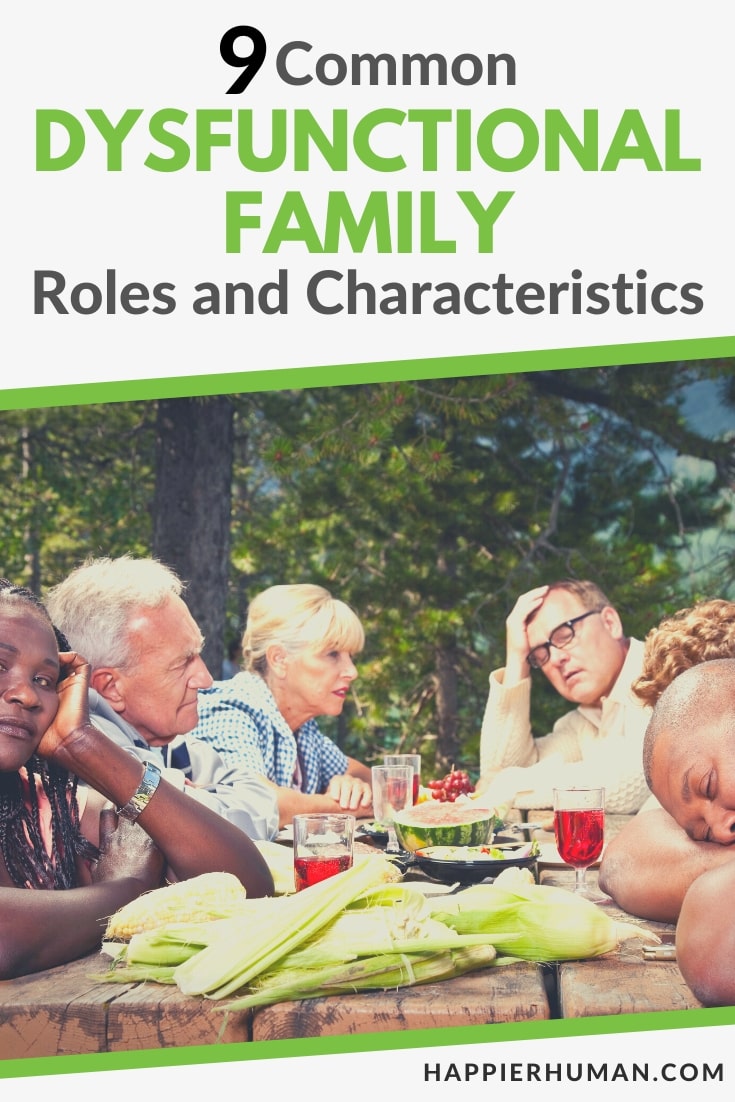Every person plays a role in their family, whether it’s healthy or dysfunctional. In a typical immediate family, there are the usual roles of mother, father, child, and sibling, and when you zoom out, there are the grandparent, aunt, uncle, and cousin roles.
But your family dynamics go way deeper than that. If your family is dysfunctional, like mine, the roles don’t balance each other out or work together properly as they do in a well-oiled healthy family machine.
Instead, dysfunctional family roles cause hurt and confusion, bring chaos, and cause upset. The people in these roles even exhibit codependent or enabling characteristics, resulting in more dysfunction.
Let’s look at the dysfunctional family roles so you can learn more and identify whether the members of your family fit into these or not.
What Does Dysfunctional Mean?
Dysfunctional refers to something that doesn’t work or function as it should. For example, if your car is dysfunctional, it doesn’t operate properly because the engine is broken or the spark plugs are faulty.
The term “dysfunction” can also refer to social behavior that’s not the norm and considered as bad. When you are dysfunctional or behave in a dysfunctional way, you are not doing what you should or what is normal.
What’s Considered Dysfunctional in a Family Structure?
A family unit can be dysfunctional, too. It’s a family structure that’s unhealthy and embroiled with conflict, animosity, criticism, indifference, hostility, and a lack of structure. It’s filled with neglect, secrecy, abuse, lack of emotional support and no empathy, and very little unconditional love.
A child’s emotional and physical needs aren’t met (often at all), and neither are those of the other family members.
There are various factors that can cause a family to become dysfunctional:
- Poor parenting (generational curse)
- Substance abuse or other kinds of addiction
- Chronic physical illness
- Poor communication
- Mental illness
- Controlling, authoritarian, or manipulative behaviors
- Unfortunate life events, like divorce, unemployment, financial distress, or death
- Insecure attachment styles
- Social, economic, political, financial, or cultural instability
Psychologists generally group dysfunctional families into these categories:
- The pathological family: One or both parents are dysfunctional because of mental illness or abuse. The kids are usually the adults here.
- The chronic conflict family: Conflict, fighting, arguments, and disagreements (as well as stress and resentment) are the norm. The family fights in unhealthy ways, and the home environment is one of extreme hostility.
- The chaotic family (severely-disturbed family): The parents abuse or neglect the kids so the kids aren’t well looked-after or protected. There are no rules or expectations, and inconsistency is the only consistent thing.
- The dominant-submissive family (authoritarian family): One or both parents are a dictator, and it’s their way or the highway. There’s little to no regard for anyone in this family, with meager love efforts, no positive reinforcement, and zero support. Consequences for misbehavior or shortcomings are severe.
- The emotionally detached family: The parents don’t show any love, support, or affection and can be classified as emotionally unavailable, distant, and cold. The kids suppress their emotions because no one talks about their feelings – ever – and when they try, they are shut down.
While dysfunctional families typically fall into one of these categories, nothing is clear-cut. In Anna Karenina, Leo Tolstoy summarized it best: “All happy families are alike, but every unhappy family is unhappy in its own way.” And that’s true.
Every dysfunctional family has their own unique way of being dysfunctional.
I want to note that it’s common for an unhealthy family to look normal or perfect to outsiders, but of course, this isn’t always the case.
An outsider will only pick up that the family structure isn’t healthy when someone in the family “loses their cool” and the cracks start to show.
On the other hand, a healthy or functional family is one in which everyone loves unconditionally, nurtures, and supports each other.
The family has a healthy attachment style, and they work on issues in a structured and non-toxic way. The family is a home, a safe space for everyone to ask questions, feel what they feel, and challenge the norm.
The Effects of Having a Dysfunctional Family
There are various effects of living or growing up in a dysfunctional family. If one of the adults in the family tends to be mentally healthy, they, too, won’t have an easy home life – just like the kids.
Here are the most common effects of having a dysfunctional family:
- Poor self-esteem and self-image
- Low self-confidence
- Unhealthy attachment styles
- Extreme shyness
- Unable to regulate their emotions or are emotionally unaware
- Poor academic or work performance as they find it challenging to focus and concentrate (or have learning deficits)
- Engage in self-destructive behavior, like self-harming
- Prone to addiction
- Mood disorders, behavior disorders, and mental health illnesses, such as anxiety, depression, paranoia, suicidal thoughts, borderline personality disorder, or post-traumatic stress disorder
- Irresponsible and destructive or become a goody-two-shoes and extreme rule follower
- Seek external validation
- Become withdrawn and socially isolated
- Become people-pleasers
- Have poor communication and decision-making skills
9 Common Dysfunctional Family Roles and Characteristics
Here are the most common dysfunctional family roles and characteristics, but note that grouping some individuals into only one category isn’t easy.
These unhealthy family roles are flexible. Oftentimes, one family member may fit predominantly in one role but they also exhibit characteristics of another. Or, they fill another role if one of the adults (for example) isn't around.
Alternatively, an individual can fit into another role when you look at larger or extended family dynamics.
1. The Hero
If you think of heroes, they are the good characters in a show, movie, or book, so how can “the hero” be part of a dysfunctional family? Or rather, how is the hero also a dysfunctional family member?
In an unhealthy family unit, the hero seems to be a well-balanced, high-functioning person.
They are the example used to prove the family is doing well. It’s like this: “Well, if daddy Jack is the CEO of a multi-million company, then the family can’t be so bad” or “If little Suzie is always at the top of her class, then our family must be doing well, right?”

It’s all a facade.
The hero (tries to) proves to outsiders that their family is all right and functioning normally, despite the whole family unit being dysfunctional. They are also the individuals who understand the toxic family dynamics better than anyone else.
If the hero of the family is a child, they are often parentified and take on the role of an adult when one of the parents is unavailable.
As a child or adult, the hero feels the immense pressure to keep up the family’s “healthy” appearance and they often try to resolve familial issues.
The key characteristics of the hero are:
- Perfectionistic tendencies
- Highly responsible
- An overachiever
- Often overworked
- Selfless
2. The Golden Child
The golden child is the person that can do nothing wrong. They are the super kid who excels at everything, and the parents brag and revere this child.
For a problematic parent, the golden child “proves” that the family is doing great and that the parent is a good person (and parent) because such a perfect person can only be the product of a supportive, healthy environment.
For a narcissistic parent, the golden child represents everything the parent loves about themselves.
If the golden child has siblings, their parents only have eyes for the super kids. All the other kids are compared unfavorably to the golden child and found wanting.
The golden child uses their “goldenness” as an escape path – to get away from the abuse their siblings suffer.
They’ll also do anything and everything in their power to do what their parents expect and want of them because they fear rejection and abuse (should they mess up).
The key characteristics of the golden child are:
- Never rock the boat (“yes and amen” behavior)
- Rule follower
- Overachievers
- Perfectionistic
- Low sense of self
- Obsessively attached to others for external validation
- Prone to nervous breakdowns
3. The Scapegoat
The scapegoat (sometimes referred to as the black sheep, but they have different roles) is the person who is blamed for everything. It can be that something was actually their fault, it could be someone else's fault, or even a made-up blame.
A scapegoat is routinely and unfairly blamed for everyone’s problems.
A parent or a child is often scapegoated. They are bullied, cast aside, singled out, and left out, and they feel unloved, isolated, and rejected.
If the parent(s) is narcissistic, it’s common that the golden child and scapegoat are pitted against each other. This is called splitting and is a form of distraction (from the family’s real issues).
The key characteristics of the scapegoat are:
- Usually the most emotionally stable in the dysfunctional family
- Are socially awkward
- Become shells of themselves or go out of their way to be socially accepted
- Can be troublemakers (because they are used to the blame and fallout)
4. The Mascot (or Clown)
The family mascot or clown is the individual who uses humor and goofiness to “deactivate” conflict. They often draw attention toward themselves and away from the volatility of the moment.
The clown may also draw attention away from the abuse that the scapegoat or black sheep suffers with their ridiculous antics or cheeky mischief.

The lightheartedness and evasion tactics simply help the family sweep their issues under the rug, which only intensifies the toxicity.
Once the clown has successfully defused stressful and volatile situations a few times, they may feel lots of pressure to crack a joke every time there’s conflict.
The key characteristics of the mascot are:
- Very humorous, making jokes and teasing to defuse stressful situations
- Appear to be jovial, even though they have bouts of depression and deal with lots of hurt
- Difficulty dealing with conflict or connecting with negative emotions
- Highly observant about changes in a person’s body language and tone so they are ready to jump in with humor (to head off drama)
5. The Black Sheep (or Identified Patient or Addict)
The black sheep of the family is also referred to as the identified patient or the addict. They are the individuals whose fault it is that the family has problems (similar to the scapegoat’s).
A black sheep is an outlier – someone who is very different from the rest of the family. Perhaps they are the only person who’s left-handed, has dark hair, or is overweight.
Or the black sheep thinks differently (has an open mind) or doesn’t follow in the family footsteps of working for daddy’s company. They may also be chronically sick or have a mental illness.
The black sheep is either happy to stand on their own and not be like the rest of the family or they are desperate for approval and love.
They may overcompensate for their shortcomings, and to cope, crawl into the bottle, porn, or other self-destructive behavior.
The key characteristics of the black sheep are:
- May hide in addiction or self-destructive behaviors as a way of coping
- Feel rejected by the family
- Very isolated or actively seeks validation and acceptance
6. The Lost Child (or the Loner)
The lost child wants to disappear. They know that being noticed equals getting into trouble, much like their black sheep or scapegoat sibling, or being in the limelight, like the hero or golden child.
In a large family, the loner child is often the middle child who just doesn’t get as much attention as the other bunch. But the lost child can be “lost” by choice too.
They may be very introverted, shy, or antisocial, and they feel shame about their family situation. If someone reaches out or gives them attention, they simply withdraw further into themselves.
As the quiet child, they prefer to spend time by themselves, hiding away from their dysfunctional family.
The key characteristics of the lost child are:
- Loner behavior
- Very independent yet indecisive
- Steer clear from confrontation
- Try to blend in or fade into the background
7. The Caretaker (or Enabler or Martyr)
The caretaker is similar to the hero in that they help maintain the appearance that the family dynamic is healthy. However, the caretaker is like the fixer of the family, always supporting and affirming the toxic behavior.
An enabler has a strong sense of responsibility and ownership to help the family with their issues, and they do everything they can to keep everyone happy – even if that means denying the real issues.
A parentified child or codependent adult can be the family’s caretaker, and they are always busy: cleaning, cooking, helping with schoolwork, or folding laundry. A martyr only knows who they are when they are taking care of others and helping.
The key characteristics of the caretaker are:
- Always taking care of everyone but themselves
- Highly responsible
- Don’t relax easily as they are hypervigilant, ready to fix and pick up the pieces
- People pleasers
8. The Mastermind (or Manipulator)
The mastermind or manipulator is the most nefarious of the dysfunctional family roles. They use other people’s weaknesses and mistakes to get what they want, whether that’s their parent’s or sibling’s insecurities or triggers.

They are masters at directing the situation to their benefit. But they do so covertly by simply pulling strings until their family members dance – just how they like it.
The manipulator switches off their emotions as a coping mechanism. They believe their behavior is justified because of the dysfunctional family dynamics they grew up in.
The key characteristics of the mastermind are:
- Manipulative, gaslighting, and controlling behavior to get what they want
- Master strategists and experts at controlling others
- Lack any sense of guilt or concern for the well-being of others
- Pretends to be perfect to the world
9. The Peacemaker
The peacemaker is the person who wants everyone to just get along because they want to live in a happy and peaceful house.
They will either be in the center of the conflict storm, trying to calm everyone down, or they’ll be baking brownies in the kitchen, happily ignorant about the conflict in the next room.
Mr. or Miss Switzerland will also try to make excuses for the toxic behavior of their family members and brush it aside. They just make the whole dysfunctional dynamic worse because they gaslight and invalidate what everyone feels and experiences.
The “Oh, they didn’t mean that” is a phrase the peacemaker is very fond of using.
The key characteristics of the peacemaker are:
- Always looking for solutions to calm everyone and fix the problem
- Mediates between family members or avoids conflict altogether
- May be emotionally immature and not experience feelings like others
Final Thoughts on Dysfunctional Family Roles
It’s never easy when it comes to navigating the dynamics of an unhealthy family. But when you know better, you can do better.
You can’t change your other family members, but you can identify which dysfunctional family role is yours, learn to love and forgive yourself, and decide how you’ll handle family gatherings (and if leaving or not coming is the best option for you).
Still not sure your family is a dysfunctional one? Check out these 11 warning signs so you can know for sure, break free from the toxicity, and live your best life.
And if you want more articles about family, be sure to check out these blog posts:
- 19 Not-So Subtle Signs Your Mother Hates You
- 21 Prayers for Your FAMILY During Difficult Times
- 7 Obvious Signs You’re a Family Oriented Person


